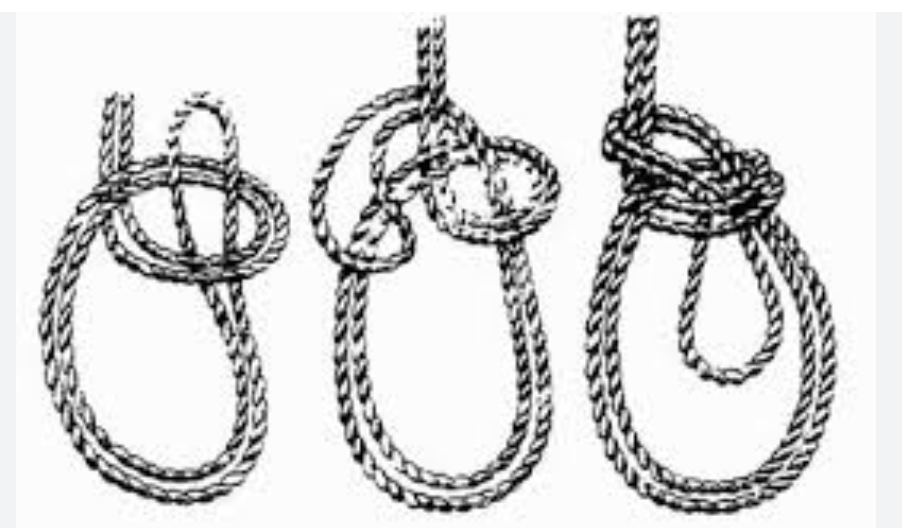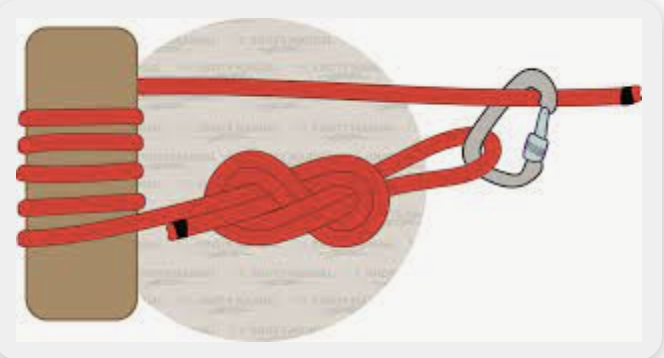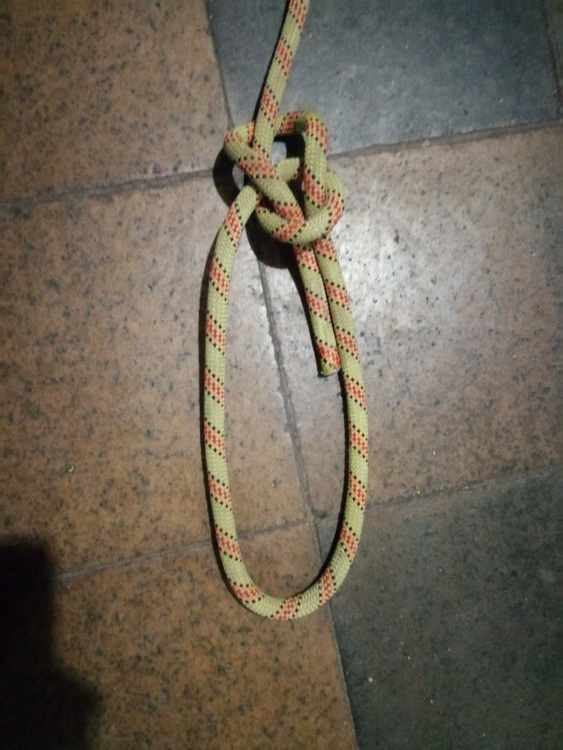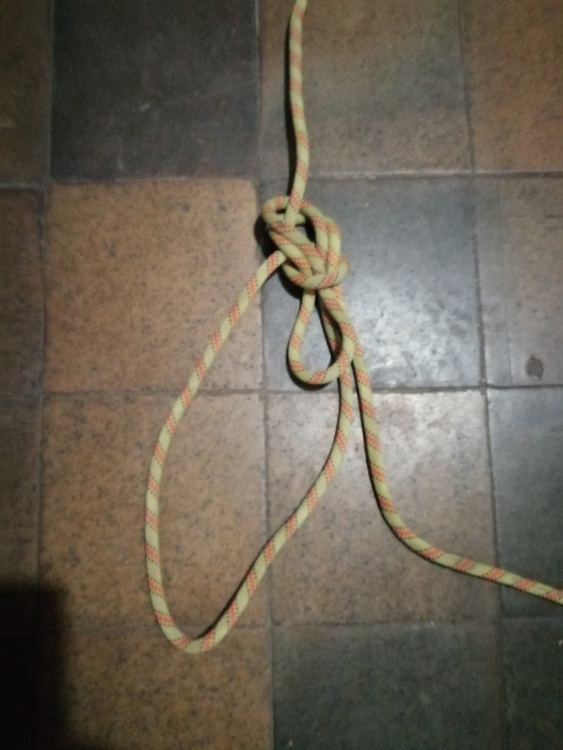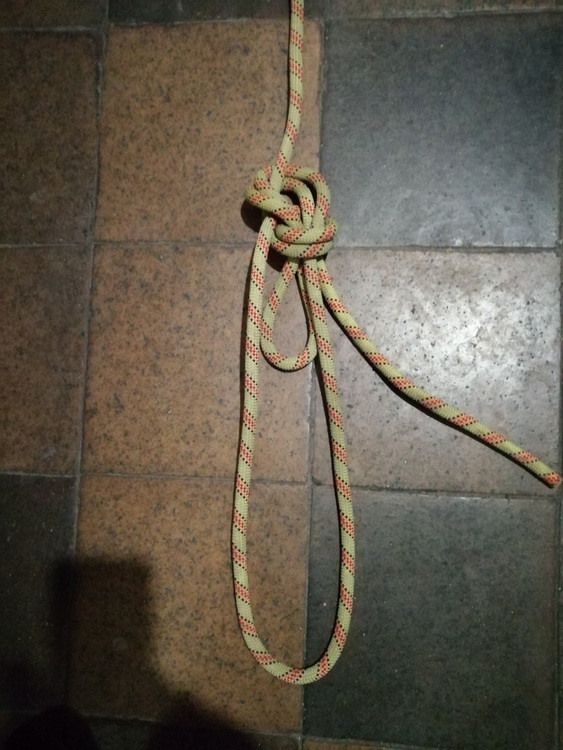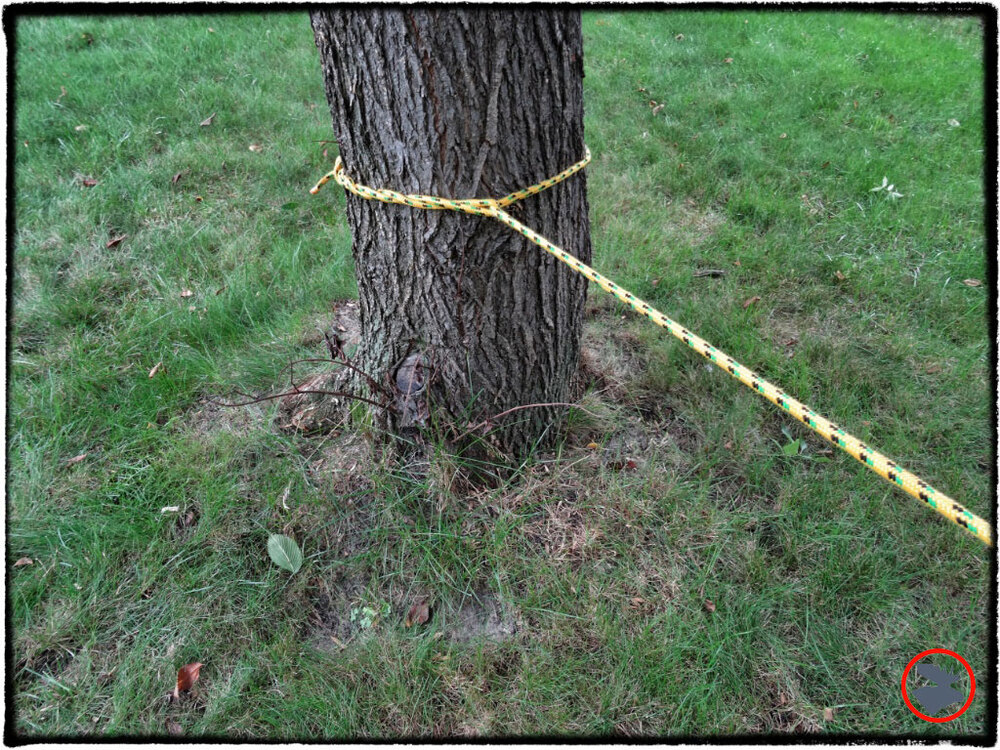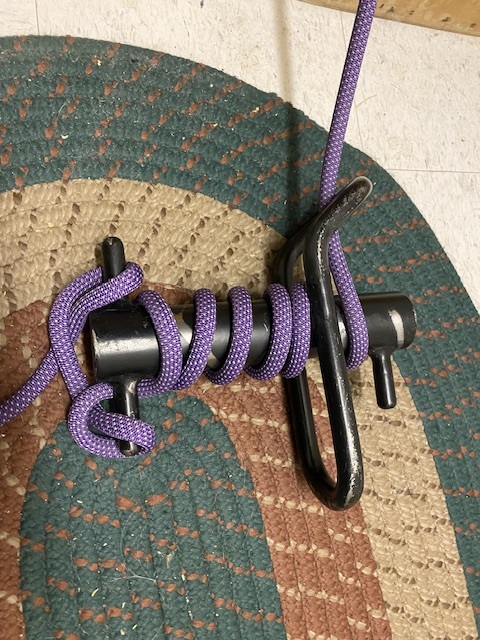Help me choose a proper knot
|
|
Hello, I need help with choosing which knot to use for my application. I'm a newbie with this stuff. Here's the most basic way of asking this question: What knot can be tied to a tractor that is easy to tie, easy to untie, and can withstand 3000 lbs of pulling force without binding up? We are pulling tree stumps on the farm using ropes and pulleys for mechanical advantage. I purchased 200 feet of Notch Kraken 5/8 rope (18,000 lb tensile), several 3/4 clevises, several snatch blocks, and tree saver straps... all rated for some pretty high forces. We're using the farm tractor to pull on the rope. So I learned how to splice a loop in the end of the Kraken rope and that worked out pretty good for the end of the rope at the anchor tree.. Then the rope feeds through my pulleys back and forth and then finally to the tractor where we use a clevis on the tow-bar.. Problem is, I can't figure out which knot to use to attach the rope to the clevis. We usually have an extra 50 to 100 feet left over so whatever I use, it has to work in the middle of the rope and I need to be able to move it after each pull. So far, my experience has shown that we make a pull and the tractor moves forward 50 feet or so, then we have to back up and adjust the tie-in point of the rope to take out the slack. I tried the mid-line Alpine Butterfly knot and that sort of worked, but on our last pull it got jammed up pretty good and its going to take some time for me to get it unbound.. I'd rather not run into that problem again. I also tried purchasing some 1/2 inch AMSteel Blue, which has a crazy high tensile strength.. I bought 6 feet of it and turned it into a Prusik Hitch. It was easy to untie and adjust, but I can see that its eventually going to melt and possibly damage my 5/8 Kraken rope. My Tractor weighs about 5000 lbs and working in our soil, I estimate it exerts about 3000 lbs of pulling force before the tires break traction and just start digging a hole. Is there a mid-line anchor loop knot that would work better then the Alpine Butterfly? Easier to untie? Or maybe a device I can purchase that grabs the rope and is easy to remove? Thank you to the experts! Reply |
|
|
Bowline with a bight, backed up with an overhand on a bight. |
|
|
You're probably in the wrong place, unless there are some professional riggers here who can help. Your loads and the ropes you are using aren't what climbers know about. The Alpine Butterfly is the climber's loop knot of choice for untying after loading, but your circumstances are obviously more extreme than the climbing applications. The best guess for a loop knot would be the bowline with a bight, which is an ordinary bowline tied using a bight of rope. This is also called a triple bowline---but in your application, the triple loop isn't possible. (This is not the same knot as a bowline on a bight, which cannot be tied around a fixed ring.) It may be that no loop knot will survive being welded in your situation, so my guess is the best thing would be no knot at all. Take a bight of rope and wrap it, say, five times around the clevis pin and secure the bight end, either with some half hitches (no load on them) or just with a carabiner. This is going to be stronger than any knot and of course will not be a problem to untie. The number of wraps needed to prevent slipping would have to be determined by (careful!) trial and error. This is called a tensionless hitch. You'd be tying it with a bight; the diagram illustrates with a stingle strand. The ability to take wraps around the clevis might be restricted by the width of clevis, so I don't know whether this idea is practical. If it isn't, you might try passing a bight through the clevis and then securing the bight end with a sequence of half-hitches. In this regard, might want to consider a buntline hitch (stunsail tack bend) tied on the clevis with a bight (not with a single strand as in the picture). Your kind salutation notwithstanding, all this is from a climber and so may not be appropriate to your gear and applications. |
|
|
This might work. In recent years whenever I've needed to tow one vehicle with another - usually cars, but occasionally work vans and at least once a [small] tree stump - I've simply used a loosely tied bowline. You'll see that while the 'encircling loop' is quite snug the 'crown' of the hitch isn't. You'd think it would just pull through but actually, in my experience, it doesn't; I think the tension in opposite directions through the hitch holds it stable while the encircling loop really clamps tight - but when the tension is relaxed the whole thing is loose again and can be easily untied. The ordinary bowline is obviously a rope-end hitch not the mid-rope one that you need, but I see no reason why this modification wouldn't work. Complete the hitch - the 'rabbit up through the hole, round the tree, then back down the hole' bit - using a bight of rope rather than the end. An additional modification you could try would be to double up the encircling loop like this. I guess you need to do a couple of trial pulls to see what works - keeping well clear in case it suddenly fails! Edit. I think this is more or less what Adam said - apart from the backup bit. |
|
|
Can you use your towbar as a sailing cleat (with redirect through the clevis)? |
|
|
I think I found the knot to use.. haven't tested it yet however.. I tied it in the office with my piece of 1/2 inch practice line and seems easy to do, and upon pulling for everything I'm worth, I didn't see anywhere it would weld itself together except at one cross-over place, and a simple reverse twist should undo that part. Opinions? https://www.youtube.com/watch?v=zB2kebIC_gY |
|
|
Murphy625 Smith, if your context is steady unidirectional load, you can use a lot of different knots including such easy to tie and untie as "timber hitch" and "two half hitch" knots. |
|
|
Using old climbing rope for towing vehicles or pulling them out of mud/sand, I simply put a stick through the middle of a figure eight on a bight. Through the knot, not in the bight. A smooth stick, such as, a 12" length of broom handle is easy to remove from the knot. That leaves some slack in the knot which can then be worked loose easily. I've broken 11mm rope, static strength >4,000 lbs, and still been able to untie the figure eight using that method. |
|
|
ClimbBaja wrote: I would very much like to see a diagram of that. I'm currently working on two different avenues.. The first being the knot video I posted.. the second is I'm welding up a 4 inch Sch40 steel pipe (10 inches long) with some brackets and a pin for my tow bar.. I will then just wrap the rope around the 4 inch pipe in much the same way they put the rope on winches.. five or six wraps and then tie it off to something. The winch setup might be the best yet because the large diameter spool (4 inch steel pipe), won't put any sharp bends in the rope so it should retain 90% or better of its strength. The other nice thing is if I ever want to go from chain to rope, my winch/spool setup would make it ridiculously easy..
|
|
|
If you're familiar with a yosemite finish, that but using a stick instead of the leftover tail. I was going to suggest similar by shoving a polished landscape spike through the middle of your alpine butterfly. Whatever you do, Don't forget to think about what goes flying in which direction if something breaks. Disclaimer: am not a professional rigger, YGD |
|
|
Arborist use a device called the Portawrap to lower sections of tree, works for horizontal pulls also. The post acts as a cleat so no knots to tie and untie. |
|
|
I am an arborist and we typically use a double bowline for most things like this. As Brocky mentioned a portawrap can be used, but I certainly wouldn't go out an buy on just for this purpose. |
|
|
The one shown was diy, much cheaper than the commercially made ones. |
|
|
Brocky wrote: Oh my! That Portawrap is very close to what I'm making using the 4 inch pipe! The only difference is that instead of needing a sling to anchor to a tree, mine was going to use a pin and clevis to attach it to the tow bar on my tractor.. Other than that, what I'm building is the exact same functional principle.. That's awesome! Thank you! |
|
|
Bb Cc wrote: You might want to check which thread you're in.. This thread is about tying off a rope mid-line to pull a tree stump. |
|
|
Get a griphoist. |
|
|
Bb Cc wrote: Agreed, OP I think knot selection is the least of your problems. Have you considered renting a stump grinder https://www.unitedrentals.com/marketplace/equipment/lawn-landscape/chippers-stumpers/stump-grinder-20-30-hp-gas-powered Or using saltpeter to "burn" the stumps out? |
|
|
Bb Cc wrote: I have no idea, I'm not feeble.. just not experienced with knots. I am however experienced with moving industrial processing machinery weighing in excess of 100,000 lbs, as a retired engineer, I have designed and supervised many such projects.. except we use chains and cables, not plastic ropes. If safety was my primary concern, I would just spend my life in an underground bunker, and so would you... and like you, I would rather live life than to be afraid of doing things or spending ridiculous amounts of my hard earned money mistakenly thinking I'm safer for it.. Much like Godwin's law, there must be a law for this too because there's at least one of you in every forum. To the other posters who intelligently answered my post, thank you very much for the help. I have built a modified version of the Portawrap that was suggested. That was a fantastic idea by the way! . Its an 8 inch long 4 inch steel pipe that attaches to the tow bar on the tractor. Six or eight wraps around the pipe and tie it off (half hitches) with a welded-in-place T bar, and I should be good. And bonus! Due to the large radius of the pipe, the rope should retain almost all of its tensile strength. If I get time, I'll post a photo after the welds are polished smooth and its sandblasted and painted up. |
|
|
I have moved large logs,trees with root wads 60 to 120ft, 2 to 3 ft diameter, with cable come alongs, excavators, griphoists. Find your working loads on stuff you work with.I have broken 1 1/8 cable chokers. Amsteel rope is the shit because if something in your system breaks it goes to ground, steel cable will fly with force and kill you. Triple bowline with a big shackle will release after big loads ( 1 inch amsteel with 17,000lb loads) thats my experiance. Be carefull!! and scared. |
|
|
Jack Carbon wrote: Good advice! That's why I bought the Notch Kraken 5/8 rope with 18,500 tensile.. My tractor is only capable of pulling about 3000 lbs before the tires start digging holes so its not going to break. The tree straps I'm using are Hi-Lift and rated at 30,000 lbs, of which I figure ~10,000 is probably safe. I'm using snatch blocks designed for 5/8 rope as well and they're supposed to break at 50,000 lbs.. Another consideration is that everything I'm using is polyester.. no nylon stretchy stuff that acts like a giant rubber band, and when I'm doing hard pulls, I loosely wrap a cheap-o home depot buffer rope around the pulling rope and anchor it with a log or whatever is available.. if something does break, it won't go but a few feet before the kinetic energy gets stolen by the buffer rope. And we've had the straps slip off several times under full pull.. its no big deal.. the rigging hardware flies about 15 feet and makes a tangled mess. Nylon is good for squishy humans that need some measure of shock absorption when they fall.. helps to prevent broken necks and backs and all that.. Polyester is far less stretchy so when things go wrong, that rubber band effect isn't such a big deal. As for the AMsteel.. For the price of 200 feet of 1 inch AMsteel, I could go buy a new backhoe and do the job.... with a paid squad of cheerleaders keeping me entertained... Thanks for the good advice! |
|
|
Don't flip the tractor on yourself |

 Continue with onX Maps
Continue with onX Maps Sign in with Facebook
Sign in with Facebook






















